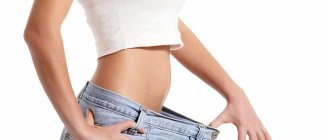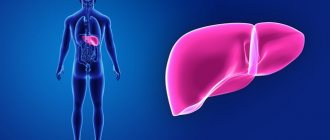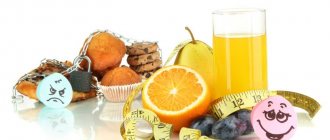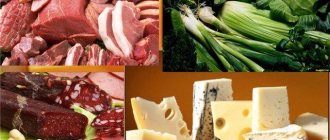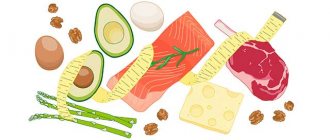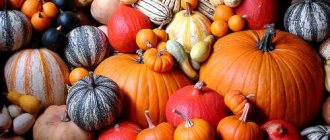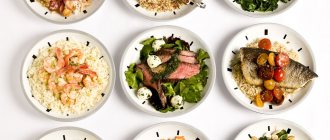Calorie calculation for weight loss
Calories are the energy that the body receives from food and then spends on any activity. A person eats foods, and the body uses them to produce energy, which it then supplies to vital organs. Energy is needed for all vital processes: mental work, breathing, heat exchange, heartbeat, and even for movement. Each product has a special chemical composition, but they all consist of the same substances, but in different proportions. So, the components are:
- carbohydrates;
- microelements;
- proteins;
- water;
- vitamins;
- fats.
Why do you need to count calories?
Without following a diet, a person tends to exceed his daily caloric intake, even if he does not eat too much, because the calorie content of all foods is different. Snacks that are not considered a full meal are swallowed and forgotten. In addition, calories are divided into “harmful” and “useful”. By consuming unlimited amounts of them, women have a desire to lose weight with the help of diets, the essence of which is the same - reducing daily caloric intake.
All diets have a common significant drawback - a limited list of products. Even if you have followed a strict diet to lose weight and achieved the desired result, you still have not abandoned your previous eating habits, so they will quickly “ruin” your slimness. Calculating the energy value of foods and the amount of food consumed should not become a temporary diet for you, but a way of life - only constant monitoring and a table will help you always have a beautiful figure and be healthy.
How to count
Having decided to switch to PP and use a calorie counting table for weight loss in everyday life, purchase a diary in which you will record your achievements. When following your daily calorie intake, write down every food you eat during the day, and also set aside a place where you will keep track of your physical activity. The third column of the table will show your weight changes - you should record your morning weight in your weight loss journal.
By comparing your weight loss results, you can adjust your diet. At the same time, focus on the minimum required by the body, and keep in mind that in order to lose weight, it must burn more calories than it received. The required amount is calculated individually for each person, because the condition of the body, the age of the person losing weight, and his physical activity are taken into account. For example, a woman who moves little can eat 2200 kcal per day; for men whose activities are not related to physical activity, the number increases to 2800 kcal/day.
To lose weight, you need to do the calculation a little differently, reducing the permissible daily caloric intake:
- women who do not engage in sports need 1000-1200 kcal/day to lose weight, men 500-600 kcal more;
- women involved in training should consume 2000-2200 kcal per day, men need to add 500 kcal to this number.
Calorie counting diet: reviews and results
Such programs, based on daily control, are useful not only for losing weight. This helps to keep the body in good shape, lead a healthy lifestyle, and organize time correctly. Such planning improves both performance and morale.
Depending on the limitation, the results obtained vary. If you follow a nutrition plan of 500-800 kcal, you will lose 10-15 kg per month, and by 1200 kcal you will lose up to 7 kg. Users note an improvement in the condition of their skin, hair and nails, and a general cleansing of the body.
The advantages include variability, variety of diet and lack of hunger.
- Elena (St. Petersburg): the system is simple, interesting, I like to try new recipes and low-calorie dishes. I don’t deny myself anything, I just replace it with healthy alternatives. – 8 kg per month is an excellent result.
- Irina: My doctor and I developed a suitable menu for the 1200 program to combat excess weight. We selected delicious dishes and products, and lost 6 kg in a couple of weeks.
- Igor Belov (nutritionist): diet - consumption of 1200 kilocalories is the safest and most convenient way to lose weight. This technique is maintained for 30-40 days, after which you will need a month's rest. A culture of low-calorie nutrition allows you to switch to healthy foods, reduce portions and painlessly give up bad eating habits.
The main thing in losing weight for a woman is to maintain health and normal metabolism. Therefore, after completing the technique, you need to switch to a healthy diet and get used to regular physical activity and activity. Any result requires consolidation.
How to correctly count calories to lose weight - table
Once you decide to reduce your body weight, you need to control your intake of high-calorie foods. The table of calorie content of weight loss products will become your faithful assistant in creating a menu, but you need to take into account other points:
- Water, tea and coffee have zero calories, but that doesn't include sugar, honey, milk or any other extra ingredients you choose to add to your drink.
- When preparing a complex dish, keep in mind that in order to calculate its energy value, you need the energy value of the products included in the composition.
- When frying, add the calorie content of the product to the calorie content of the oil in which it is fried.
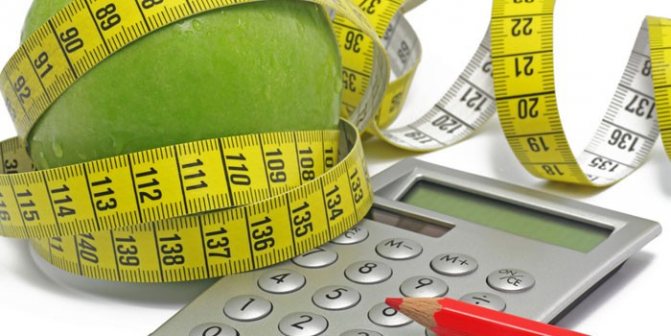
Food calorie table
Knowing your allowable daily calorie intake for weight loss, you can adjust your menu and plan your diet correctly. A calorie counting table for weight loss will help you with this - thanks to it you will find out the composition of dietary fat and the calorie content of food products that are considered the most popular and accessible to everyone. In the table, data on calorie content and composition are displayed per 100 g of product.
| Product name | Calories (kcal) | Squirrels | Fats | Carbohydrates |
| Berries, fruits | ||||
| Orange | 45 | 0,9 | 0,2 | 8,1 |
| Cherry plum | 27 | 0,2 | 0 | 6,9 |
| A pineapple | 49 | 0,4 | 0,2 | 10,6 |
| Apricot | 47 | 0,9 | 0,1 | 10,8 |
| Avocado | 208 | 2,0 | 20,0 | 7,4 |
| Watermelon | 40 | 0,6 | 0,1 | 5,8 |
| Cowberry | 45 | 0,7 | 0,5 | 9,6 |
| Banana | 90 | 1,5 | 0,1 | 21,8 |
| Cherry | 25 | 0,8 | 0,5 | 11,3 |
| Grape | 70 | 0,6 | 0,2 | 16,8 |
| Grapefruit | 30 | 0,8 | 0,5 | 11,3 |
| Pear | 42 | 0,4 | 0,3 | 10,9 |
| Melon | 45 | 0,6 | 0,3 | 7,4 |
| Strawberries | 38 | 0,8 | 0,4 | 7,5 |
| Blackberry | 32 | 2,0 | 0 | 6,4 |
| Cranberry | 33 | 0,5 | 0 | 6,8 |
| Kiwi | 59 | 1,0 | 0,6 | 10,3 |
| Gooseberry | 48 | 0,7 | 0,2 | 12,0 |
| Dogwood | 41 | 1,0 | 0 | 10,5 |
| Lemon | 30 | 0,9 | 0,1 | 3,0 |
| Mandarin | 41 | 0,8 | 0,2 | 7,5 |
| Raspberries | 45 | 0,8 | 0,5 | 8,3 |
| Peach | 45 | 0,9 | 0,1 | 11,3 |
| Currant | 43 | 1,0 | 0,4 | 7,3 |
| Plum | 44 | 0,8 | 0,3 | 9,6 |
| Blueberry | 44 | 1,1 | 0,4 | 7,6 |
| Cherries | 53 | 1,1 | 0,4 | 11,5 |
| Apple | 45 | 0,4 | 0,4 | 9,8 |
| Greens, vegetables | ||||
| Eggplant | 28 | 1,2 | 0,1 | 4,5 |
| Green peas | 75 | 5,0 | 0,2 | 13,8 |
| White cabbage | 23 | 1,8 | 0,1 | 4,7 |
| Broccoli | 28 | 3,0 | 0,4 | 5,2 |
| Brussels sprouts | 12 | 4,8 | 0 | 8,0 |
| Cauliflower | 18 | 2,5 | 0,3 | 5,4 |
| Red cabbage | 27 | 0,8 | 0 | 7,6 |
| Sauerkraut | 28 | 1,8 | 0,1 | 4,4 |
| Zucchini | 18 | 0,6 | 0,3 | 4,6 |
| Boiled potatoes | 82 | 2,0 | 0,4 | 16,7 |
| Potato | 80 | 2,0 | 0,4 | 18,1 |
| Fried potato | 192 | 2,8 | 9,5 | 23,4 |
| Bulb onions | 43 | 1,4 | 0 | 10,4 |
| Green onion | 18 | 1,3 | 0 | 4,6 |
| Red onion | 42 | 1,4 | 0 | 9,1 |
| Carrot | 33 | 1,3 | 0,1 | 6,9 |
| Pickled cucumber | 16 | 2,8 | 0 | 1,3 |
| Fresh cucumber | 15 | 0,8 | 0,1 | 2,8 |
| Parsley | 23 | 3,7 | 0,4 | 7,6 |
| Sweet pepper | 27 | 1,3 | 0 | 5,3 |
| Tomato | 20 | 0,6 | 0,2 | 4,2 |
| Turnip | 23 | 1,5 | 0,1 | 6,2 |
| Radish | 16 | 1,2 | 0,1 | 2,5 |
| Radish | 16 | 1,2 | 0,1 | 3,4 |
| Rhubarb | 13 | 0,7 | 0,1 | 2,5 |
| Asparagus | 20 | 1,9 | 0,1 | 3,1 |
| Beet | 40 | 1,5 | 0,1 | 8,8 |
| Salad | 11 | 1,2 | 0,3 | 1,3 |
| Celery | 12 | 0,9 | 0,1 | 2,1 |
| Dill | 30 | 2,5 | 0,5 | 6,3 |
| Pumpkin | 28 | 1,3 | 0,3 | 7,7 |
| Red beans | 93 | 8,4 | 0,3 | 13,7 |
| White beans | 102 | 7,0 | 0,5 | 16,9 |
| Garlic | 60 | 6,5 | 0,5 | 29,9 |
| Horseradish | 49 | 3,2 | 0,4 | 10,5 |
| Sorrel | 17 | 1,5 | 0,3 | 2,9 |
| Spinach | 216 | 2,9 | 0,3 | 2,0 |
| Nuts | ||||
| Peanut | 551 | 26,3 | 45,2 | 9,9 |
| Almond | 600 | 18,6 | 57,7 | 16,2 |
| Walnut | 650 | 15,2 | 65,2 | 7,0 |
| Pine nut | 620 | 11,6 | 61,0 | 19,3 |
| Cashew | 643 | 25,7 | 54,1 | 13,2 |
| Hazelnut | 670 | 16,1 | 66,9 | 9,9 |
| Pistachios | 556 | 20,0 | 50,0 | 7,0 |
| Eggs | ||||
| Ostrich egg | 118 | 12,2 | 11,7 | 0,7 |
| Quail egg | 168 | 11,9 | 13,1 | 0,6 |
| Chicken egg | 157 | 12,7 | 10,9 | 0,7 |
| Mushrooms | ||||
| Dried mushrooms | 210 | 23,4 | 6,4 | 31,0 |
| White mushroom | 25 | 3,7 | 1,7 | 1,1 |
| Fried mushrooms | 165 | 4,6 | 11,5 | 10,7 |
| Milk mushrooms | 16 | 1,8 | 0,5 | 0,8 |
| Chanterelles | 20 | 1,6 | 1,1 | 2,2 |
| Raincoats | 27 | 4,3 | 1,0 | 1,0 |
| Butter | 19 | 2,4 | 0,7 | 0,7 |
| Honey mushrooms | 20 | 2,2 | 1,2 | 0,5 |
| Boletus | 30 | 3,3 | 0,5 | 3,7 |
| boletus | 30 | 2,3 | 0,9 | 3,7 |
| Dried foods | ||||
| Figs | 290 | 3,1 | 0,8 | 57,9 |
| Raisin | 270 | 2,9 | 0,6 | 66,0 |
| Dried apricots | 290 | 5,2 | 0,3 | 51,0 |
| Kishmish | 310 | 2,3 | 0 | 71,2 |
| Prunes | 290 | 2,3 | 0,7 | 57,5 |
| Dates | 290 | 2,5 | 0,5 | 69,2 |
| Dried apples | 210 | 2,2 | 0,1 | 59,0 |
| Cheeses, dairy products | ||||
| Cow cheese | 260 | 17,9 | 20,1 | 0 |
| Yogurt 1.5% | 51 | 5,3 | 1,5 | 7,5 |
| Kefir 0% | 30 | 3,0 | 0,1 | 3,8 |
| Kefir 1% | 38 | 2,8 | 1,0 | 4,0 |
| Kefir 3.2% | 60 | 2,8 | 3,2 | 4,1 |
| Whole milk | 68 | 3,2 | 3,6 | 4,8 |
| Milk 3.2% | 60 | 2,9 | 3,2 | 4,7 |
| Ryazhenka 6% | 85 | 5,0 | 6,0 | 4,1 |
| Curdled milk | 59 | 2,8 | 3,2 | 4,1 |
| Cream 20% | 300 | 2,8 | 20,0 | 3,7 |
| Cream 10% | 120 | 3,0 | 10,0 | 4,0 |
| Sour cream 20% | 210 | 2,8 | 20,0 | 3,2 |
| Sour cream 10% | 115 | 3,0 | 10,0 | 2,9 |
| Parmesan | 330 | 33,0 | 28,0 | 0 |
| Dutch cheese | 357 | 26,0 | 26,8 | 0 |
| Lambert cheese | 377 | 23,7 | 30,5 | 0 |
| Russian cheese | 371 | 24,1 | 29,5 | 0,3 |
| Processed cheese | 257 | 16,8 | 11,2 | 23,8 |
| Cheddar | 392 | 23,0 | 32,0 | 0 |
| Edam | 330 | 24,0 | 26,0 | 0 |
| Sausage cheese | 278 | 23,0 | 19,0 | 0 |
| Feta | 290 | 17,0 | 24,0 | 0 |
| Curd cheese | 380 | 9,5 | 21,3 | 36,0 |
| Cottage cheese 18% | 226 | 14,0 | 18,0 | 2,8 |
| Low-fat cottage cheese | 80 | 16,3 | 1,0 | 1,3 |
| Bakery products | ||||
| Sugar | 290 | 0 | 0 | 99,7 |
| Rye flatbread | 375 | 8,0 | 18,3 | 44,2 |
| Drying | 330 | 11,3 | 4,4 | 70,5 |
| Butter pastries | 300 | 20,0 | 6,0 | 35,0 |
| Wheat bread | 265 | 8,1 | 1,0 | 48,8 |
| Bread Darnitsky | 206 | 6,6 | 1,1 | 41,0 |
| Rye bread | 210 | 6,6 | 1,2 | 34,2 |
| Cereals, legumes, flour | ||||
| Beans | 57 | 6,0 | 0,1 | 8,5 |
| Green peas (canned) | 55 | 3,6 | 0,1 | 9,8 |
| Green peas (fresh) | 73 | 5,0 | 0,2 | 13,8 |
| Dried green peas | 298 | 20,5 | 2,0 | 53,3 |
| Rye flour | 347 | 10,7 | 1,9 | 56,8 |
| Wheat flour | 348 | 9,2 | 1,2 | 74,9 |
| Semolina | 340 | 10,3 | 1,0 | 73,3 |
| Buckwheat | 346 | 12,6 | 3,3 | 62,1 |
| Oatmeal | 374 | 1,3 | 6,1 | 59,5 |
| Pearl barley | 342 | 9,3 | 1,1 | 73,7 |
| Wheat groats | 352 | 11,5 | 1,3 | 62,0 |
| Barley grits | 343 | 10,4 | 1,3 | 66,3 |
| Cornflakes | 369 | 6,9 | 2,5 | 83,6 |
| Pasta | 350 | 11,2 | 1,6 | 68,4 |
| Cereals | 305 | 11,9 | 7,2 | 69,3 |
| Rice | 337 | 7,1 | 0,7 | 78,0 |
| Soybeans | 395 | 34,9 | 17,3 | 17,3 |
| Lentils | 310 | 21,6 | 1,1 | 48,0 |
| Beans | 93 | 8,4 | 0,3 | 13,7 |
| Barley flakes | 315 | 9,38 | 3,6 | 79,4 |
| Seafood | ||||
| Chum salmon caviar | 245 | |||
| Granular caviar | 250 | |||
| Pollock caviar | 130 | |||
| Fried carp | 145 | |||
| Carp | 46 | |||
| Chum salmon | 157 | |||
| Canned fish in its own juice | 120 | |||
| Canned fish in oil | 320 | |||
| Crabs | 70 | |||
| Shrimps | 85 | |||
| Bream | 48 | |||
| Smoked salmon | 385 | |||
| Fried salmon | 145 | |||
| Sea kale | 16 | |||
| Pollock | 70 | |||
| Navaga | 44 | |||
| Cancers | 75 | |||
| Perch | 95 | |||
| Stellate sturgeon | 137 | |||
| Atlantic herring | 57 | |||
| Salaka | 98 | |||
| Zander | 43 | |||
| Sprats in oil | 250 | |||
| Cod | 59 | |||
| Pike | 41 | |||
| Meat products | ||||
| Ham | 365 | |||
| Goose | 300 | |||
| Brisket | 475 | |||
| Fried beef | 170 | |||
| Beef stew | 180 | |||
| Turkey | 150 | |||
| Korean | 430 | |||
| Smoked sausage | 380 | |||
| Boiled sausage | 250 | |||
| Rabbit meat | 115 | |||
| Boiled chicken | 135 | |||
| Fried chicken | 210 | |||
| Beef liver | 100 | |||
| Kidneys | 66 | |||
| Sausages | 235 | |||
| Pork chop | 265 | |||
| Duck | 405 | |||
| Pork stew | 350 | |||
| Heart | 87 | |||
| Sausages | 160 | |||
| Language | 165 | |||
| Veal | 90 | |||
| Fats, sauces | ||||
| Rendered fat | 930 | |||
| Ketchup | 80 | |||
| Creamy mayonnaise | 745 | |||
| Mayonnaise | 625 | |||
| Sandwich margarine | 670 | |||
| Margarine for baking | 675 | |||
| Creamy margarine | 745 | |||
| Mayonnaise light | 260 | |||
| Ghee | 885 | |||
| Corn oil | 900 | |||
| Sunflower oil | 900 | |||
| Butter | 750 | |||
| Soybean oil | 900 | |||
| Olive oil | 824 | |||
Calculator
A calorie chart helps, but many people find it tedious to use. For this reason, those who are losing weight should take a closer look at a reference book indicating the calorie content of ready-made meals, or popular online calculators. Electronic counters can be used not only to count calories, but also dietary supplements, vitamins and minerals in a certain dish. The online program helps calculate how many beneficial components meat, vegetables, fish or fruits lose during cooking.
How to understand that a product is high in calories
To learn to understand the calorie content of foods, you will have to understand their composition, that is, KBJU. So, in front of you is a certain product. What is it like, what does it consist of? If there is flour (especially wheat) or sugar, carbohydrates will most likely predominate.
If a dish is fried and contains a lot of oil and fat, it is logical to assume that it contains more fat. Well, if your product is eggs, cottage cheese, meat or soybeans, then this product contains a considerable amount of protein.
One gram of protein contains 4 calories
.
One gram of fat contains as many as 9. One gram of carbohydrates also contains 4 calories
.
Carbohydrates are divided into fast and slow. Slow carbohydrates are so called because the body spends more time processing them than fast ones. Accordingly, they are absorbed gradually and provide the body with nutrition for a long time.
Fast carbohydrates are absorbed so actively that when there are large quantities of them (in cases of overeating), the body does not have time to release the required amount of insulin for processing. As a result, the body burns the part that was converted into energy with the help of insulin.
But we convert the part for which there was not enough insulin into fat - “for a rainy day.” That is why there are no “bad” or “good” carbohydrates - you just need to know the moderation in everything.
Fats are either “healthy” or “harmful”. Here, harm or benefit is much easier to determine - everything that is natural can be considered useful. Everything artificially created is harmful.
Squirrels are squirrels in Africa too. Animal products, legumes, soy - all these are rich in proteins. All proteins are good and healthy in their own way.
How to count individual foods - porridge, meat, vegetables
Slow carbohydrates include, first of all, porridge. They are well absorbed by the body and guarantee satiety for a long period. The carbohydrates that make up porridge are the fuel that allows us to move and live.
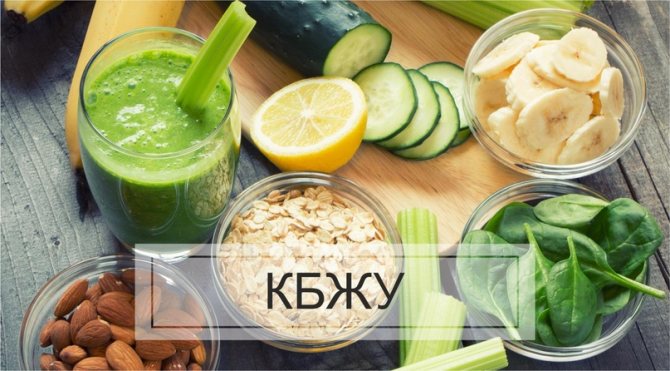
There is an opinion that it is easier and easier to count porridge if you weigh the finished product after cooking. In fact, everything is completely different. In order for grains to cook, they must absorb some amount of water. And, as a rule, these numbers can differ greatly from each other.
Let's dive into the numbers. You can cook 100 grams of dry porridge, and in the end it will weigh 250 grams, or you can cook it so that it weighs 500 grams. If we take buckwheat porridge as an example, then on average 250 grams of buckwheat boiled in water contains 246 calories, and the same porridge that has been boiled to 500 grams contains 493 calories. Although, in essence, you eat the same portion of porridge, just with different amounts of water.
For meat and vegetables, the counting rules are much simpler. These figures are already entered into the application database, taking into account the boil-off coefficient. Therefore, there is no need to invent a wheel, just consider “chicken thigh baked in a sleeve” - without bones, and “stewed cabbage” - accordingly, already stewed.
You will achieve the most accurate calculations when preparing simple dishes containing a minimum number of ingredients. We do not count salt and spices.
In electronic calculators for counting calories you can often find ready-made, multi-component menus, for which all the numbers have already been calculated. No one forbids using these calculations, but keep in mind that your ratio of products in any dish may differ from the one from which these data were calculated.
Expert opinion
Fetisova Anna Andreevna
Fitness trainer, professional nutrition consultant.
There is no need to chase “pure” foods that contain pure proteins or pure carbohydrates. Your task is to learn how to correctly arrange them so that in total your menu contains both in the quantity you need.
Liquid calories - be sure to count them!
A little about liquid calories. Everything that is not water is considered food. Therefore, we must take into account everything we “eat” and drink during the day. Just for fun, open the calorie calculator and look in numbers at how many calories are in compotes, juices, soda, milk, yoghurts, smoothies.
This all counts too, and can also be deposited on your sides. Alcoholic drinks are especially high in calories - for example, 500 ml of beer contains an average of 200 calories.
How to count food if you don’t have a scale at hand?
There are situations when the scales are simply not at hand at the right time. We go on vacation, on business trips, and have a snack on the go. We do not always have the opportunity to weigh the product at home, on our scales. But there are a couple of little tricks that will help you out in such moments.
Almost all supermarkets are equipped with electronic scales. Here you can weigh what you plan to buy for a snack. If there are no scales within easy reach, pick up the required portion of food and, after paying at the checkout, look at the numbers on the receipt. The weight of the product must be there.
Another way to count is products with labels. Many products nowadays have individual packaging, which indicates the number of grams, and even KBJU. You yourself know what to do with this data.
Calculation of daily calorie intake for weight loss
How many calories you can consume per day can be easily calculated. You just need to multiply the value of your weight in kg by 24 - the resulting number will be the rate of calorie consumption for the body at rest (due to this amount of energy, it will ensure the functioning of the processes necessary for human life). Even when calculating the daily calorie intake for weight loss, you need to take into account the recommended dose of BJU: the daily menu should consist of 20% fat, 40% carbohydrates and 40% protein.

Physical activity rate
The amount of daily calories depends on how active a person is. In this case, the number of acceptable norms must be multiplied by a coefficient expressing motor physical activity. This indicator has an average value:
- 1.2 – for people who are very overweight or lead a completely inactive lifestyle;
- 1.4 – for those who play sports at least 3 times/week;
- 1.6 – for people working in an office and those who rarely do physical labor;
- 1.5 – for those who train daily and do physical labor.
Basal metabolic rate
A calorie counting table will help you lose weight, but to calculate your daily calorie intake, you need to take other values into account. So, to maintain weight, your basal metabolic rate needs to be multiplied by your activity ratio. To lose weight, the daily norm needs to be reduced: for women to 1200 kcal, for men - to 1800 kcal. To lose weight, you need to either reduce your calorie intake by eating less or increase your physical activity. It is worth noting that before increasing the load when losing weight, you need to calculate how many calories you can eat before training.
Learning to understand products
In addition to calories, for effective weight loss it is necessary to keep a record of KBZHU. This is important to ensure that the body receives all the necessary components in the right quantities - after all, lack of nutrition is worse than overeating.
You may already be aware that all foods contain proteins, fats and carbohydrates. Let's look at what it is, and at the same time check whether you understand the essence of this issue correctly.
Proteins are complex substances made up of amino acids. They are the “building material” for your tissues and muscles and ensure the functioning of the immune system. Proteins are of plant and animal origin.
Fats are organic compounds responsible for the “reserve fund” of energy in the body. Fats regulate and normalize the production of vital hormones, control metabolism and are a material for the construction of cell membranes.
Carbohydrates are the main source of energy. They provide a person with normal well-being and give him strength to work and study. Carbohydrates also help protein digest better.
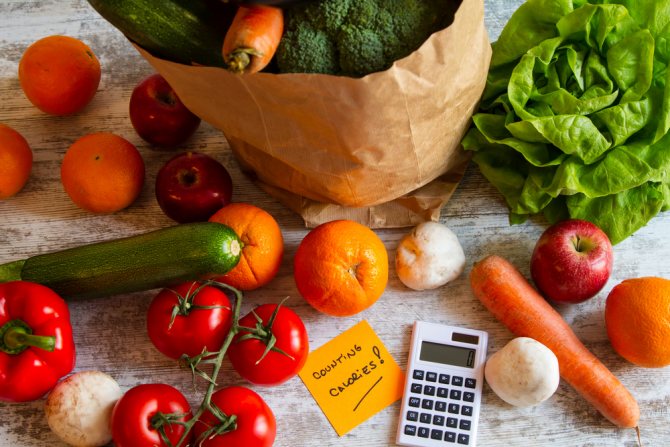
There are no organic products, any of the components of KBZHU
in its purest form.
Each product (if it is natural) contains some proportion of certain components, just in different concentrations - some more, some less.
Maintaining the correct amount of KBZHU will not only speed up your metabolism, but will also allow your metabolism to work like a clock, without storing excess, but using up the entire daily menu.
Calorie diet
For those who have problems with weight, nutritionists have developed a special system - calculating the calorie content of consumed foods according to a table. While on this diet, you don’t need to give up your favorite delicious foods, because the system’s design is as simple as possible - you just need to reduce the number of servings and their volume. Reviews of this diet suggest that you can easily lose 4 kg of excess weight in a month (depending on your initial weight). The diet is absolutely safe for health, provided that you do not reduce your daily caloric intake below the minimum threshold of 1200 kcal.
A calorie-counting diet won't make you hungry. You can see this by looking at its sample menu:
- breakfast - 200 g of salad (fresh cabbage and carrots), seasoned with 0.5 tsp. vegetable oil, a piece of boiled sausage (50 g) or chicken cutlet, bread and unsweetened tea;
- snack – 100 g of citrus jelly, a glass of lemon jelly;
- lunch – 150 g of bean soup, 150 g of vegetable roast with pork, a cup of rowan tea, 100 g of potato cookies;
- afternoon snack – a glass of kvass made from the extract, 2 loaves of bread covered with a thin layer of apricot jam;
- dinner – 100 g of buckwheat, 100 g of boiled chicken fillet, a cup of tea with an apple;
- at night - a glass of low-fat kefir.

How to choose calorie-rich diet recipes
A calorie table for weight loss may not help you achieve your goal if you systematically break the rules. So, when you are planning to count calories, you should:
- Limit your fat intake. Animal fat has twice the calorie content of carbohydrates. If the menu contains no more than 30% fat, then the body does not require an increase in the dose of carbohydrates and protein, due to this the calorie content of the diet becomes 10% less.
- Minimize your sugar intake. Any type of sugar or its substitute increases appetite, which causes a person to overeat, which is unacceptable when losing weight. A healthy menu should contain no more than 20 g of sugar/day.
- Increase your consumption of fiber (found in cereals, fruits, vegetables) and pectins. This kind of food is the best for weight loss - it is digested more slowly and fills you up faster.
